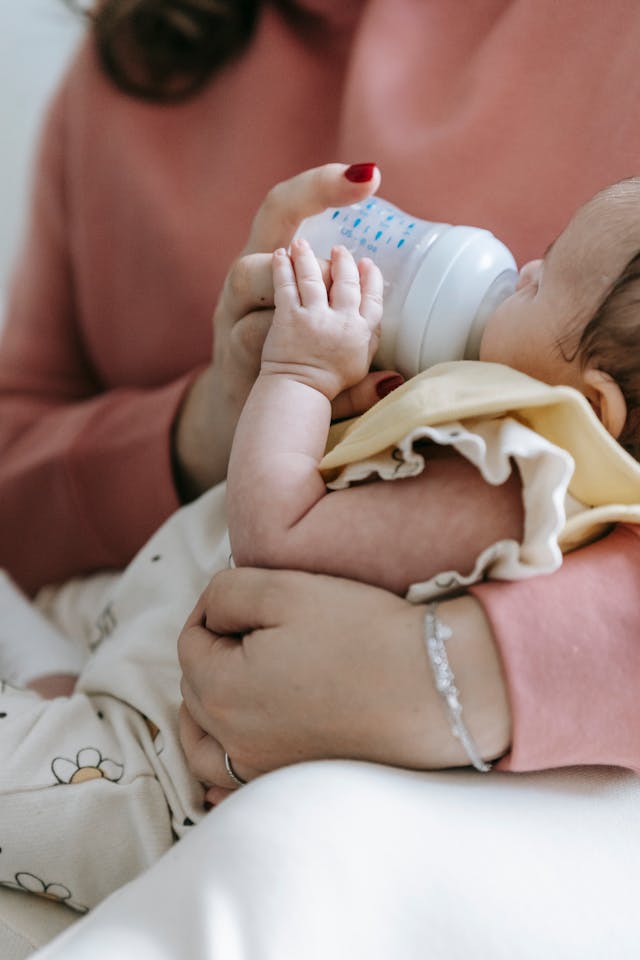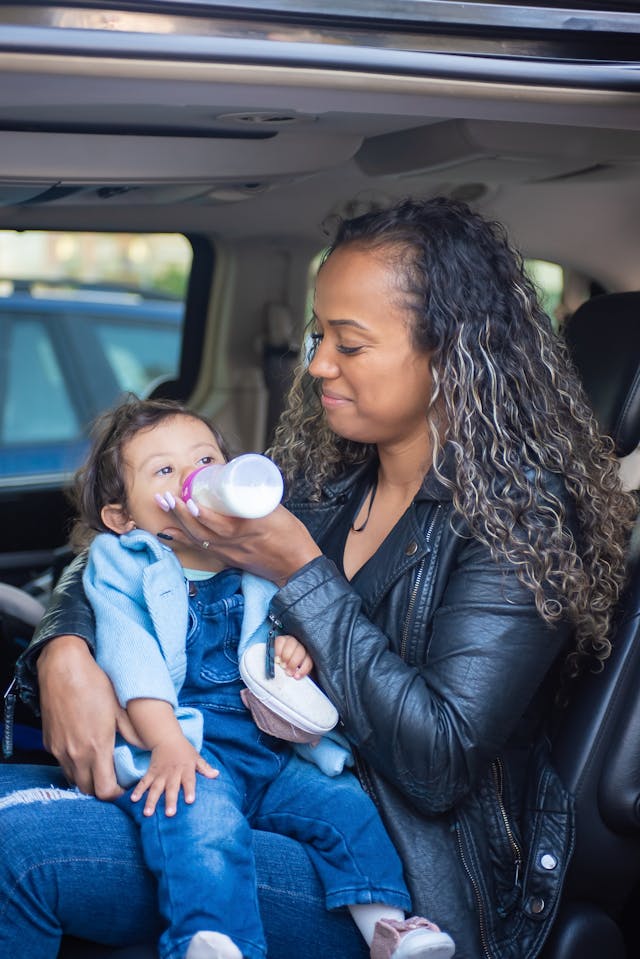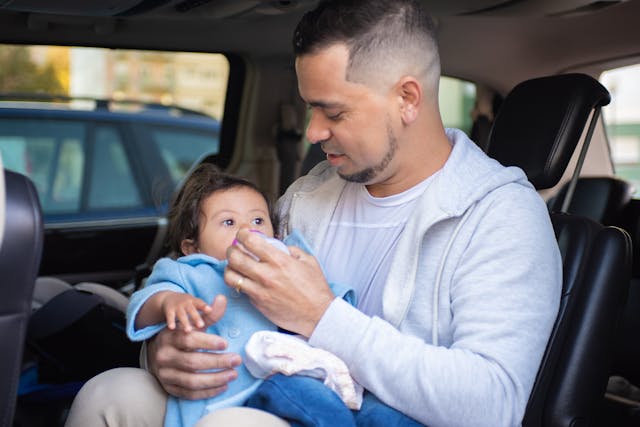Feeding Baby in a Car Seat: Can You Feed a Baby in a Car Seat?

Can You Feed a Baby in a Car Seat
Let’s be honest, traveling with a baby can feel like a marathon you never trained for—one with pit stops for diaper changes, soothing sessions, and of course, feedings. When you’re cruising down the highway, it might seem oh-so-tempting to just hand your baby a bottle or a pouch in their car seat. After all, it’s just a quick snack—what’s the big deal, right? Well, before you start playing “super parent” while zooming along at 60 miles per hour, let’s talk about the reality of feeding your baby in a car seat, and why “snack time on the go” is often more trouble than it’s worth.
The Hidden Risks of Feeding in a Car Seat
Choking and Aspiration Hazards:
Car seats are designed to keep your baby safe during sudden stops or collisions, not to create the perfect dining chair. The reclined angle combined with the jostling of the car can make it easier for milk or food to go down the “wrong pipe.” That’s right—aspiration (when fluid enters the lungs) is a real possibility. Even soft foods like those adorable squeezable pouches aren’t immune to causing choking. And here’s the kicker: Choking is eerily silent. Unlike that loud sobbing you can’t miss, choking can happen quietly, leaving you totally unaware. Trying to safely handle this emergency while driving? Picture yourself pulling off an impossible acrobatic stunt—no thank you.
Risks of Feeding in Motion:
You might think, “I’ll just lean over and nurse or bottle-feed my baby—it’ll be fine.” But imagine suddenly hitting the brakes! Not only can your baby choke, but you could also become a human ping-pong ball, bouncing dangerously around the car. Your child’s safety harness won’t protect you, and now you’ve got a whole new level of risk. In other words, it’s just not worth playing stunt double with your baby’s lunchtime.
Motion Sickness:
If your baby already looks like they’re auditioning for a mini roller-coaster commercial when you drive, adding food to that mix can lead to tummy troubles. Nausea and vomiting can make for one messy, tear-filled trip. And as if that weren’t enough, a baby lying back in a reclined car seat is at even higher risk of choking on that upchucked meal. Let’s just say this is not the sweet family adventure you planned.
Projectiles in Collisions:
Ever thought of your baby’s sippy cup as a weapon? In a collision, items become projectiles. A bottle, utensils, or even a container of applesauce can transform into a flying object. It might sound funny in theory (“Attack of the Killer Sippy Cups!”), but the reality can be seriously scary.
Why Car Seats Make Lousy Dining Chairs

Car seats are bucket-shaped for safety, not for snack-time comfort. This reclined design means your baby’s pelvis is tilted, their tiny tummy is getting pressed, and feeding is just plain uncomfortable. Instead of thinking of the car seat as a “portable highchair,” it’s best to see it as a short-term safety device for travel—not a mealtime zone.
What to Do Instead:
At rest stops or safe parking areas, free your little one from their “bucket throne.” Cradle them in your arms for bottle-feeding, giving them a sense of security and bonding. If they’re ready for solids and can sit independently, let them sit upright on your lap or use a small travel highchair. Feeding your baby outside the car seat ensures they’re comfortable, safe, and at less risk of choking.
Making Travel Plans that Suit Your Baby’s Needs
Frequent Breaks:
If you’ve got a road trip in the works, schedule regular stops—every two hours for most babies, and every 30 minutes if your baby is really young or was born prematurely. These breaks let your baby stretch, play, and eat in a more natural position. Think of it as turning your travel time into a mini adventure: a quick park stop, a scenic overlook, or even a quick dance party by the car (trust me, nothing entertains onlookers more than parents doing the Macarena in a rest area).
Plan Ahead:
Road trips with babies require a dash of strategy. Pack portable highchairs, easy-to-clean bibs, and maybe that special spoon shaped like an airplane. (Yes, airplane spoons are still cool.) Giving yourself extra time to pull over and feed sets you up for a more relaxing journey. It’s better than trying to maneuver a spoonful of applesauce into your baby’s mouth mid-drive—believe me.
Special Considerations for Preemies and Toddlers
Premature Babies:
Preemies often have more delicate systems and may struggle with staying safe and comfortable in a car seat for long periods. The American Academy of Pediatrics suggests monitoring preemies in car seats before leaving the hospital. Studies show that both preterm and full-term babies can have higher heart rates and lower oxygen levels sitting upright during a bumpy ride. Frequent breaks matter even more for these tiny travelers.
Feeding Toddlers:
Toddlers love snacks, but when the car is rolling, it’s best to say “no” to crunchy crackers or anything that could cause choking. If hunger strikes, pick super-soft options—like applesauce pouches—and only offer them when you’ve pulled over. If your toddler is throwing a fit that could rival a rock star’s dressing room tantrum, it’s safer (and wiser) to stop the car and feed them calmly. Trust me, you don’t want to juggle a tantrum and a steering wheel at the same time.
Preventive Measures and General Safety Tips
Stay Organized:
Keep your car neat and avoid clutter that can become a flying circus during accidents. Store gear securely, and always follow the car seat manufacturer’s cleaning instructions to avoid weakening the seat’s safety features.
Prioritize Safety Over Convenience:
It might feel like a hassle to stop for every feeding, but the alternative could be disastrous. Plus, these breaks can become cherished moments: chatting with your baby, playing peek-a-boo in the parking lot, or simply taking in some fresh air together. By treating feeding breaks as part of your travel routine, you’ll end up with a safer, calmer trip—and fewer sour milk smells in your car.
Final Words
When it comes to feeding baby in a car seat, the risks far outweigh the convenience. Between choking hazards, aspiration risks, and projectile sippy cups (yes, we’re still giggling at that mental image), it’s just not worth it. Instead, plan your travel to include safe, comfortable feeding stops. Nurture your baby during these times, whether you’re breastfeeding, bottle-feeding, or spooning out mashed veggies. In doing so, you’ll enjoy a smoother ride, keep your baby safer, and who knows—you might even discover a fun family tradition or two along the way.
So, pack your bags, plan those pit stops, and hit the road with confidence. Travel smart, feed safe, and create memories without any scary “feeding in the car” stories to share later. Safe travels and happy feeding!


